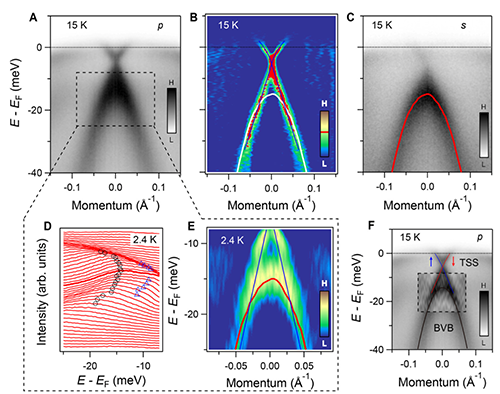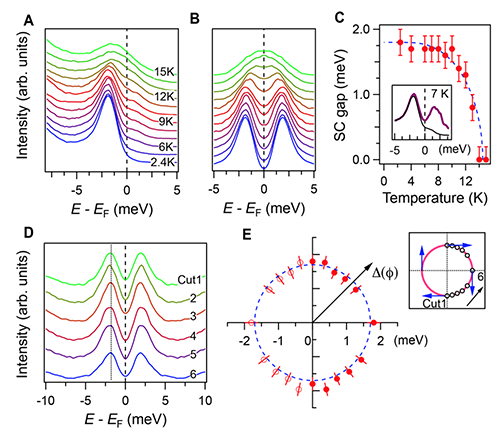Topological Superconductivity Discovered on Surface of an Iron-based Superconductor
Date:19-03-2018 Print
Topological superconductor is one of the most popular topics in condensed matter physics. Its exotic quasi-particle excitation, known as Majorana mode, can be used to build topological quantum computer. Based on previous theoretical and experimental study, topological superconductor can only be found in either intrinsic chiral p-wave superconductor or topological insulator/ BCS superconductor heterostruture. P-wave case is very sensitive to disorder of the material. Heterostructure case is difficult to fabricate and suffered interface problem. Generally, they all need ultra-low temperature (below 4.2 K, which is temperature of He-4) to achieve topological superconducting states. That makes topological superconductor a rare case in laboratory and not so robust under multiple manipulation.
Four years ago, ZHANG Peng and Prof. DING Hong from Institute of Physics, CAS found some signatures that the upper p band in iron-based superconductor FeSe falling down and invert its position with dxz band with Te substitution. With the collaboration with prof. FANG Zhong and DAI Xi ‘s theory group, they found this band inversion is topological nontrivial and topological surface state should exist in this high temperature superconductor. That creates an opportunity to combine these two ingredients in one single crystal and eliminate problems encountered in previous proposals. They show an another road to realize higher temperature topological superconductor on the surface of Iron-based superconductor with topological non-trivial band structure.
Recently, by making use of laser-based high resolution angle resolved photoemission spectroscopy (HR-ARPES) and spin-resolved angle resolved photoemission spectroscopy (SARPES), Dr. ZHANG Peng who is a postdoc in prof. SHIN Shik’s group of Tokyo university, prof. DING Hong in Institute of Physics, CAS, and collaborators, they measured the electronic states inside spin-orbital coupling gap which is less than 20 meV in iron-based superconductor Fe(Te,Se), Dirac-cone type surface states was clearly observed. They found these Dirac-cone type bands are spin-momentum locking which is a main feature of topological surface state. The orbital character of each bands were also verified by measuring band structure under different light polarization configurations.
Subsequently, they found surface states open isotropic superconducting gap when cooling down below superconducting critical temperature. The evolution of gap size under different temperature is quiet mimic BCS type behavior. That shows proximity induced s-wave superconducting gap opening on spin non-degenerated topological surface states in one single crystal. It fulfills one of theoretical model proposed by Liang Fu and Charles Kane that this superconductivity is effective spinless p-wave and Majorana bound states exist on its vortex core.
The easy growth of high quality single crystal and relative high superconducting critical temperature make Fe(Te,Se) a good platform to study the behaviors of Majorana bound states and even, in the future, fabricate efficient devices for topological quantum computation.
This study entitled “Observation of topological superconductivity on the surface of an iron-based superconductor” was published on Science.
The study was supported by the National Science Foundation, the Ministry of Science and Technology of China, the Chinese Academy of Sciences and grants from US.
 |
| Fig. 1 Observation of Dirac-cone type topological surface bands (Image by Institute of Physics) |
 |
| Fig. 2 spin-momentum locking observed on topological surface states (Image by Institute of Physics) |
 |
| Fig. 3 s-wave superconducting gap on the topological surface states. (Image by Institute of Physics) |
Contact:
Institute of Physics
DING Hong
Email:dingh@iphy.ac.cn
Key word:
Topological Superconductor; Majorana; High Temperature
Abstract:
Majorana bound states, an exotic non-Abelian qausi-particle excitation in topological superconductors, can be used as topological qubit. An angle resolved photoemission spectroscopy study of Fe(Te/Se) reveals topological superconducting state on the surface, providing a promising platform for further study the behavior of Majorana bound states and even for future quantum computation.

